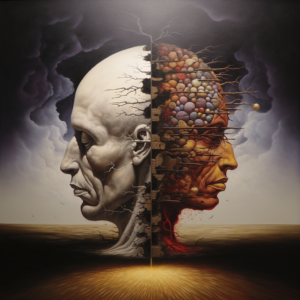Ego vs Soul: Unearthing Authenticity Through Portrait Photography
If you’ve clicked on this article, you’re probably curious about this “ego vs. soul” thing I’m talking about. Well, it’s not just about some philosophical rambling. It’s about how understanding this battle can open the door to an extraordinary and deeply fulfilling life. And believe it or not, it’s directly connected to the philosophy of Stonetree Creative I use here at the studio
This Ego vs. Soul Debate
The ego represents that part of yourself concerned with how you’re perceived by others and your self image. It acts like a bodyguard on alert and ready to step in when it senses a threat, to your self esteem. Seeking validation it often triggers responses when it perceives danger. Simply put your ego can be both your ally and biggest enemy always striving to safeguard you.
In contrast your soul embodies your voice. The essence of who you are. It craves authenticity, connection and genuine experiences without the need for validation embracing vulnerability along the way. Its often associated with those profound ‘gut instincts we experience. [Note: There’s research on the connection between the mind and gut; however I’ll delve into that topic in a future blog post.]
Unpacking the Ego: Exploring Its Positives and Negatives
Contrary to common beliefs the ego is not inherently negative. Sigmund Freud, known for his discussions, on the ego viewed it as essential in helping us navigate lifes aspects. A part of our psychological makeup.
If we didn’t have our ego it would feel like we’re trapped in a world of illusions somewhere between versions of reality.
Yet our ego can sometimes go overboard in trying to shield us holding back our progress and steering us away, from being true to ourselves. It can make us overly focused on seeking approval from others and meeting standards causing us to portray a version of ourselves that doesn’t truly reflect who we are at the core. This is why people often seek validation through “likes” on media – it gives them a sense of belonging and acceptance.. This is where the problem arises.

The Soul: Your Uninhibited, Genuine Self
On the contrary your soul – your self – isn’t concerned about conforming to societal expectations or worrying about being judged. It embraces vulnerability and craves deep meaningful connections. The soul desires fulfillment. Strives for peace and joy. It represents your self reveling in its genuineness.
When we quiet the demands of our ego and listen to the whispers of our soul that’s when we establish real connections with ourselves and others. And believe me this connection plays a role in capturing moments through photography.
The Influence of Ego and Spirit, in the Art of Portrait Photography
In my experience as a portrait photographer I’ve observed firsthand the interplay between ego and spirit. The ego often dictates how people present themselves during photo sessions, driven by a desire to conform to norms and seek approval.
Yet when individuals tap into their selves listen to that voice something extraordinary happens. The resulting portraits not capture their appearance but also reveal their true essence, personality and soul. It’s a depiction of who they’re at their core.
Building Connections; The Stonetree Creative Approach
At Stonetree Creative my goal is to help clients bridge this gap between ego and spirit. Through conversations and interactions in each session I strive to truly understand my clients. We explore their aspirations, fears, perceptions and expectations. By uncovering their selves beneath layers of driven facades we aim to reveal the essence of who they truly are.
This deep understanding guides me during the photo shoot process allowing me to capture more, than an image but a reflection of their innermost self.
It’s a process, with wonderful outcomes.
Exploring the Science; The Concept of Polyvagal Theory
One might question why the internal struggle between ego and soul exists. Why do we often find ourselves torn between seeking approval and striving for authenticity? Well science provides an explanation – enter the theory.
Crafted by Stephen Porges the polyvagal theory suggests that our vagus nerve, a player in our system influences our social interactions and stress responses. It consists of two components. The ventral vagal complex is tied to engagement and relaxation processes while the dorsal vagal complex is connected to reactions such as ‘freezing’ in threatening situations.
Grasping this theory sheds light on why our ego tends to dominate – it’s a part of our self defense mechanism. However it also indicates that we hold the ability to tap into our system fostering deeper connections with ourselves and others ultimately reaching out to connect with our soul. I’ve been delving into this concept during my therapy sessions over the years.
Ego versus Soul; Concluding Remarks
The ego shouldn’t be viewed as an adversary but as a safeguard. To lead an life finding harmony, between our ego and soul is essential.
When we achieve this when we let our true selves shine that’s when the magic happens. In photoshoots and, in our lives.
Cheers to embracing who we are and living authentically. Here’s to capturing portraits that reflect our stories. Join me on this journey as we walk this path together creating a portrait experience that’s truly transformative.

